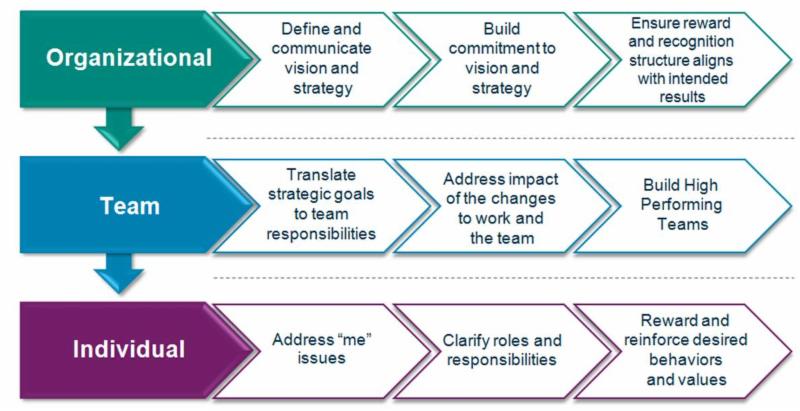Cultural transformation initiatives can be important strategic levers used to create alignment between an organization’s values, beliefs, and strategic vision. Directly addressing elements of an organization’s culture can combat stagnant work practices and reinvigorate top talent. One of the guiding principles for achieving cultural change is that culture change takes place more effectively when worked at three levels: organizational, team, and individual.
At the organizational level, senior leaders need to clearly communicate, model, and reinforce the values, beliefs, and culture they want to create. At the team level, the focus needs to be on translating strategic goals into team responsibilities, then addressing the impact of these changes on the team. At the individual level, the personal dynamics of the strategy should be addressed, e.g., specific behaviors that individuals need to start, stop, and continue doing to be effective. In addition, individuals should be rewarded for demonstrating commitment to the new cultural beliefs. Working at each of the three levels creates consistency and reinforcement that helps drive behavior and cultural change. A framework for addressing issues at the three recommended levels of the organization is presented below.
Culture change can be difficult to implement because values and beliefs are difficult to modify. To ensure that these efforts create underlying changes that will last, work at each of these levels should also include examination of potential risks, barriers, and obstacles to success. It is important to assess beliefs and fears at each of these levels early and make plans to address the findings.
WLH Consulting, Inc. (“WLH”) has helped numerous clients transform their internal culture to realize their strategic vision. In one particular case, a client needed to bring two distinct cultures together following a merger. Individuals from both organizations came together, found common ground, and created shared commitment to the new organization. Working at all three levels helped ensure clear, consistent messages were communicated about what was changing and why, and helped effect cultural change by creating common values and goals.
To achieve the established financial and business targets, leadership recognized the need to get teams up and running and quickly aligned around common goals and beliefs. The senior team underwent a disciplined process to define the new culture by clearly articulating the vision, values, and core beliefs. To build commitment around the vision, workshops were held to give teams an opportunity to explore what the vision meant, to further define the desired behaviors needed to accomplish goals, and for each individual to understand their accountability for realizing the vision.

